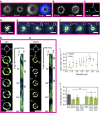Still and rotating myosin clusters determine cytokinetic ring constriction
- PMID: 27363521
- PMCID: PMC4932180
- DOI: 10.1038/ncomms11860
Still and rotating myosin clusters determine cytokinetic ring constriction
Abstract
The cytokinetic ring is essential for separating daughter cells during division. It consists of actin filaments and myosin motors that are generally assumed to organize as sarcomeres similar to skeletal muscles. However, direct evidence is lacking. Here we show that the internal organization and dynamics of rings are different from sarcomeres and distinct in different cell types. Using micro-cavities to orient rings in single focal planes, we find in mammalian cells a transition from a homogeneous distribution to a periodic pattern of myosin clusters at the onset of constriction. In contrast, in fission yeast, myosin clusters rotate prior to and during constriction. Theoretical analysis indicates that both patterns result from acto-myosin self-organization and reveals differences in the respective stresses. These findings suggest distinct functional roles for rings: contraction in mammalian cells and transport in fission yeast. Thus self-organization under different conditions may be a generic feature for regulating morphogenesis in vivo.
Figures






Similar articles
-
An actin-myosin-II interaction is involved in maintaining the contractile ring in fission yeast.J Cell Sci. 2015 Aug 1;128(15):2903-18. doi: 10.1242/jcs.171264. Epub 2015 Jun 19. J Cell Sci. 2015. PMID: 26092938
-
Three myosins contribute uniquely to the assembly and constriction of the fission yeast cytokinetic contractile ring.Curr Biol. 2015 Aug 3;25(15):1955-65. doi: 10.1016/j.cub.2015.06.018. Epub 2015 Jul 2. Curr Biol. 2015. PMID: 26144970 Free PMC article.
-
Fission yeast myosin Myo2 is down-regulated in actin affinity by light chain phosphorylation.Proc Natl Acad Sci U S A. 2017 Aug 29;114(35):E7236-E7244. doi: 10.1073/pnas.1703161114. Epub 2017 Aug 14. Proc Natl Acad Sci U S A. 2017. PMID: 28808035 Free PMC article.
-
Molecular form and function of the cytokinetic ring.J Cell Sci. 2019 Jun 17;132(12):jcs226928. doi: 10.1242/jcs.226928. J Cell Sci. 2019. PMID: 31209062 Free PMC article. Review.
-
Cytokinesis in fission yeast: a myosin pas de deux.Microsc Res Tech. 2000 Apr 15;49(2):152-60. doi: 10.1002/(SICI)1097-0029(20000415)49:2<152::AID-JEMT7>3.0.CO;2-7. Microsc Res Tech. 2000. PMID: 10816254 Review.
Cited by
-
Ordering Single Cells and Single Embryos in 3D Confinement: A New Device for High Content Screening.J Vis Exp. 2016 Sep 18;(115):51880. doi: 10.3791/51880. J Vis Exp. 2016. PMID: 27684088 Free PMC article.
-
Mechanoregulated inhibition of formin facilitates contractile actomyosin ring assembly.Nat Commun. 2017 Sep 26;8(1):703. doi: 10.1038/s41467-017-00445-3. Nat Commun. 2017. PMID: 28951543 Free PMC article.
-
Symmetry Breaking and Emergence of Directional Flows in Minimal Actomyosin Cortices.Cells. 2020 Jun 9;9(6):1432. doi: 10.3390/cells9061432. Cells. 2020. PMID: 32527013 Free PMC article.
-
The ultrastructural organization of actin and myosin II filaments in the contractile ring: new support for an old model of cytokinesis.Mol Biol Cell. 2017 Mar 1;28(5):613-623. doi: 10.1091/mbc.E16-06-0466. Epub 2017 Jan 5. Mol Biol Cell. 2017. PMID: 28057763 Free PMC article.
-
Dual Targeting of Mesenchymal and Amoeboid Motility Hinders Metastatic Behavior.Mol Cancer Res. 2017 Jun;15(6):670-682. doi: 10.1158/1541-7786.MCR-16-0411. Epub 2017 Feb 24. Mol Cancer Res. 2017. PMID: 28235899 Free PMC article.
References
-
- Rappaport R. Cytokinesis in Animal Cells Cambridge Univ. Press (1996).
-
- Schroeder T. E. Molecules and Cell Movement 305–334Raven Press (1975).
-
- Eggert U. S., Mitchison T. J. & Field C. M. Animal cytokinesis: from parts list to mechanisms. Annu. Rev. Biochem. 75, 543–566 (2006). - PubMed
-
- Carvalho A., Desai A. & Oegema K. Structural memory in the contractile ring makes the duration of cytokinesis independent of cell size. Cell 137, 926–937 (2009). - PubMed
Publication types
MeSH terms
Substances
LinkOut - more resources
Full Text Sources
Other Literature Sources

